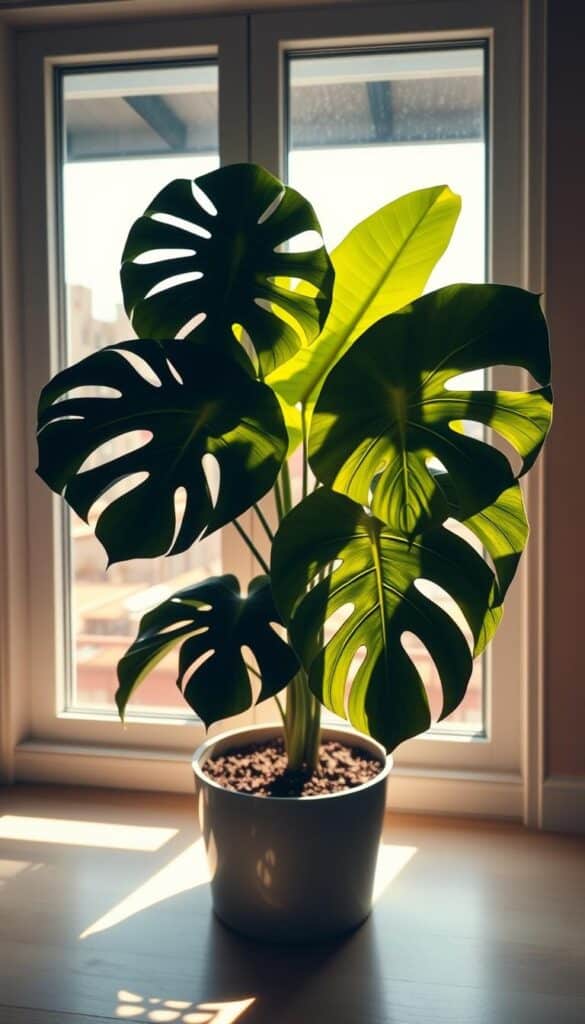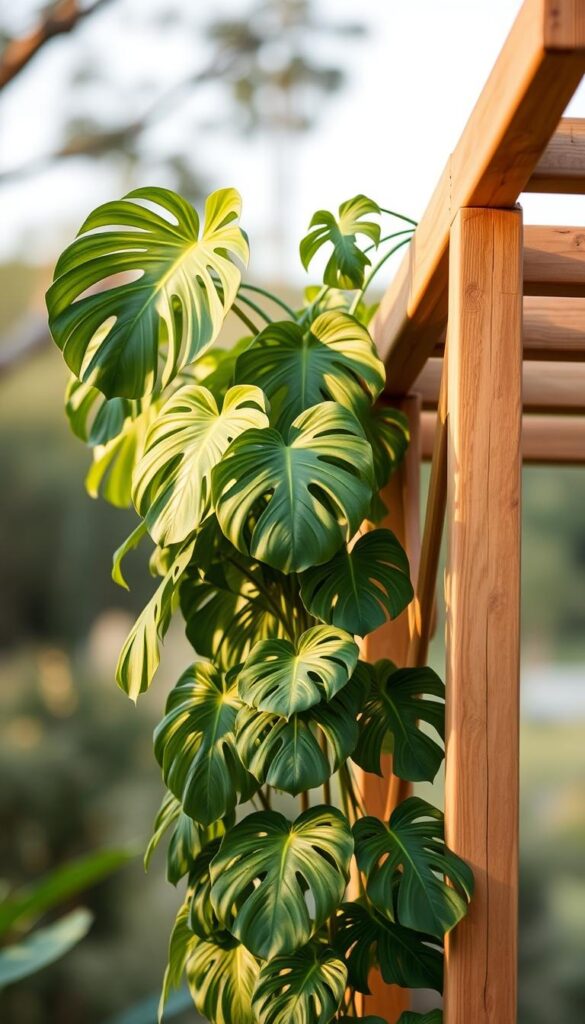Imagine stepping into a lush, tropical forest, where the air is thick with humidity and sunlight filters through the canopy above. This is the natural habitat of the Monstera Standleyana Five-Hole Plant, a species that has captured the hearts of many plant enthusiasts. What makes this plant so unique? For starters, its striking variegation adds a touch of elegance to any room, making it a standout piece in indoor gardens.
While it’s often called the “five-hole plant,” this Monstera species doesn’t develop the fenestrations commonly seen in its cousin, the Monstera Deliciosa. Instead, it boasts beautiful, unique leaf patterns that set it apart from other plants. If you’re a fan of Philodendron Cobra or Monstera Deliciosa, you’ll likely fall in love with this plant’s distinct charm.
Natively from Central and South America, the Monstera Standleyana adapts wonderfully to indoor environments. It’s relatively compact, typically growing to about 3 feet tall, and thrives in controlled home settings with proper care. Whether you’re a seasoned plant parent or just starting your green journey, this plant offers a rewarding experience with its manageable care requirements and stunning appearance.
Key Takeaways
- The Monstera Standleyana Five-Hole Plant is known for its striking variegation and unique leaf patterns.
- It doesn’t develop fenestrations like some other Monstera species.
- It’s native to Central and South America and adapts well to indoor environments.
- The plant typically grows to about 3 feet tall in a controlled home setting.
- It’s relatively easy to care for, making it a great choice for both new and experienced plant enthusiasts.
Getting Started with Your Monstera Standleyana Five-Hole Plant
Bringing a new plant into your home is an exciting experience, especially when it’s as unique as the Monstera Standleyana Five-Hole Plant. Before you begin, it’s essential to understand what makes this plant special and how to choose a healthy specimen.
Understanding Its Unique Characteristics
This plant is often mistaken for its cousin, the Monstera Deliciosa, due to their similar names. However, the Monstera Standleyana stands out with its striking variegated leaves and compact growth, making it a favorite among plant collectors. Unlike other Monstera species, it doesn’t develop holes in its leaves but instead showcases beautiful, unique patterns that add elegance to any room.
Its manageable size, typically growing up to 3 feet tall, makes it perfect for indoor spaces. Whether you’re a seasoned plant parent or just starting out, this plant’s adaptability and manageable care requirements ensure a rewarding experience.
Selecting a Healthy Specimen
When choosing your Monstera Standleyana, look for vibrant, sturdy leaves and a robust stem. A healthy plant will have a well-developed root system and be free from pests. Proper labeling is crucial, so ensure the plant is correctly identified to avoid confusion with similar species.
Ideal Lighting and Humidity for a Thriving Houseplant
Creating the perfect environment for your Monstera Standleyana involves understanding its lighting and humidity needs. Proper conditions ensure vibrant growth and prevent common issues.
Bright Indirect Light Tips
Place your Monstera near an east-facing window for optimal light. Direct sunlight can cause leaf burn, so sheer curtains are a good filter. This setup promotes healthy growth and maintains stunning variegation.

South-facing windows are too intense, while north-facing may not provide enough light. Balance is key for this tropical plant.
Maintaining Optimal Humidity and Temperature
Humidity levels between 55-80% are ideal. Use a humidifier or a moisture tray with water and pebbles to achieve this. Average home humidity often falls below this range, so monitoring is essential.
Temperature-wise, keep your Monstera in an area between 65-75°F (18-24°C). Avoid placing it near drafts or extreme temperature fluctuations to maintain stability.
Watering and Soil: Crafting the Perfect Environment
Proper watering and soil care are essential for your Monstera Standleyana to thrive. These elements work together to create a nurturing environment for healthy growth.
Watering Guidelines to Prevent Overwatering
To avoid overwatering, always check the soil moisture first. Stick your finger into the soil up to the first knuckle. If the top 2 inches feel dry, it’s time to water.
- Water heavily, allowing excess to drain completely to prevent root rot.
- Use room-temperature water to avoid shocking the roots.
Watering once a week is usually sufficient, but this may vary depending on your home’s humidity and temperature.
Choosing the Right Well-Draining Potting Mix
Select a potting mix designed for tropical plants. You can also create your own mix using orchid bark, perlite, or vermiculite for better drainage.
- Aim for a mix that retains some moisture but drains excess water quickly.
- Repot your plant every 1-2 years in the spring to refresh the soil and provide a larger pot if needed.
Nurturing Growth: Pruning, Fertilizing, and Support
To keep your Monstera Standleyana thriving, regular maintenance is key. This includes pruning, fertilizing, and providing support for its natural climbing habit.
Effective Pruning Practices for Better Growth
Pruning is essential for maintaining a healthy and attractive plant. I recommend using clean, sharp tools to prevent spreading diseases. Here are some tips:
- Remove any damaged or overgrown leaves to encourage new growth and maintain shape.
- Prune in the spring or summer when the plant is actively growing.
- Make clean cuts just above a node to promote healthy regrowth.
Regular pruning also helps maintain a bushy appearance and prevents the plant from becoming leggy.
Fertilizer Tips for a Lush, Healthy Plant
Feeding your Monstera Standleyana with the right fertilizer can boost its growth and variegation. Here’s what I suggest:
- Use a balanced, water-soluble fertilizer during the growing season (spring and summer).
- Dilute the fertilizer to half the recommended strength to avoid burning the roots.
- Fertilize once a month, skipping during the fall and winter when the plant is dormant.
A well-fed plant will have vibrant leaves and strong stems, making it a stunning addition to your indoor space.
Providing the Right Support
Monstera Standleyana is a climbing plant and benefits from support as it grows. I recommend using a moss pole or trellis to guide its stems. This not only keeps the plant upright but also encourages better leaf growth and display.

By following these care practices, you’ll be able to enjoy a healthy, thriving Monstera Standleyana that brings beauty and life to your home.
How I Propagate My monstera standleyana five-hole plant at Home
Propagating your Monstera Standleyana can be a fun and rewarding process. I’ve found that with the right techniques, you can successfully grow new plants to share or expand your collection.
Step-by-Step Stem Cutting Propagation
To start, I choose a healthy stem with at least one node and several leaves. Using clean, sharp tools is crucial to prevent any infection. I then place the cutting in a glass of clean water, changing it every few days until roots begin to develop.
Once the roots are well-established, I transfer the cutting to a pot filled with well-draining soil. Keeping the soil moist but not soggy helps the new plant thrive. I’ve found that using a propagation tray or a humid environment can significantly improve rooting success.
Propagation by Separation: Tips and Tricks
Another effective method is propagation by separation during repotting. I gently separate the roots and plant the separated sections in new pots. This technique works best when the plant is already mature and has multiple growth points.
Practical hints like sterilizing tools and using rooting hormones can boost success rates. I also recommend monitoring the new plants closely to ensure they adapt well to their new environment.
Troubleshooting Common Issues and Managing Pests
Keeping your Monstera Standleyana healthy involves watching out for common problems and knowing how to fix them. Regular checks can help catch issues early, making them easier to manage. This section covers signs of watering issues and pests, plus tips to keep your plant strong.
Identifying Signs of Overwatering and Underwatering
Watering is a common trouble spot. Overwatering can make leaves turn yellow and drop, while underwatering leads to wilted, dry leaves. Check the soil often to avoid these problems.
- Overwatering: Leaves turn yellow and may fall off. The soil stays wet for too long, which can hurt the roots.
- Underwatering: Leaves become wilted and dry. The soil feels hard and cracked when it’s time to water.
Strategies for Pest Control and Leaf Care
Pests can harm your plant. Keep an eye out for bugs like mealybugs and spider mites. Use neem oil to safely treat infestations. For leaf care, remove any brown or damaged leaves to keep your plant looking its best.
- Check leaves and stems regularly for signs of pests.
- Use neem oil to treat infestations early on.
- Remove brown or damaged leaves to keep your plant healthy and strong.
By staying alert and taking quick action, you can prevent small issues from becoming big problems. Regular care and checks will help your Monstera Standleyana stay vibrant and thrive in your home.
Conclusion
Bringing your Monstera Standleyana Five-Hole Plant home is just the start of an exciting journey. To ensure it thrives, remember to provide bright, indirect light, water carefully to avoid overhydration, and use a well-draining soil mix. Propagation can be done through stem cuttings or separation, and offering support like a moss pole will encourage healthy growth.
Regular pruning and balanced fertilization are key for maintaining its stunning variegation. Keep an eye out for pests and address any issues promptly. With patience and attentive care, your plant will flourish, bringing beauty and life to your space.
We’d love to hear about your experiences with the Monstera Standleyana! Share your tips and stories in the comments below to help grow our community of plant enthusiasts.
